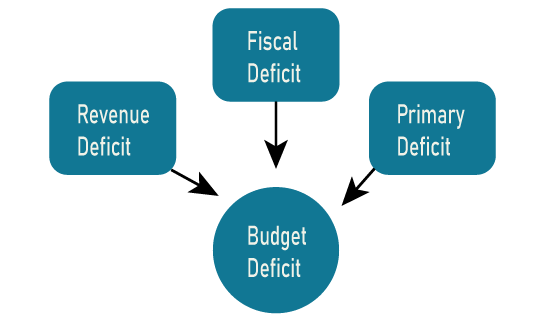Advantages and Disadvantages of Deficit FinancingDeficit financing is the process by which the government invests higher funds than it collects in taxes and makes up the deficit by borrowing money or creating additional funds. When the government's overall income (revenue account + capital account) is less than its total expenditures, deficit financing may result. 
The government might decide to borrow money from the public by issuing bonds and other securities, ordering the RBI to create fresh currency notes, or withdrawing funds from its cash balance deposited with the RBI. Ad-hoc Treasury Bills are used to get loans from the central bank, private banks, or even state governments to cover the deficit. Why is Deficit Financing Necessary?Higher economic growth is a priority for growing nations like India. Finances are necessary for greater economic growth. The government is responsible for raising money since the private sector is reluctant to invest significantly.
Types of Deficit FinancingThere are several ways to finance a budget deficit, including:

1. Revenue Deficit: The revenue deficit is the difference between revenue expenditures and revenue receipts.
2. Fiscal Deficit: The fiscal deficit is the difference between total expenditure and total receipt, excluding borrowings.
3. Primary Deficit: The primary deficit denotes the distinction between interest expenses and the fiscal deficit.
While the primary deficit depicts the government's borrowing demands without considering interest payments on prior loans, the fiscal deficit depicts the government's borrowing demands with interest payments on previous loans included. In other terms, a primary deficit denotes borrowing by the government to cover current-year expenses and receipts. What are the primary goals of Deficit Financing?Deficit financing's primary goals are as follows:
Deficit financing's Purpose
Impacts on the Country's Deficit Financing
What Causes Government Budget Deficit?When expected government spending grows faster than estimated revenues, a budget imbalance or deficit financing results. Either raising the tax rate or mandating higher prices for commodities and essential public services can be used to account for these discrepancies. Additionally, the government's built cash reserves or borrowing from the banking sector can be used to cover the deficit. 
In India, the current budget deficit of the union government is claimed to be financed by borrowing from the RBI (Reserve Bank of India) and drawing down the government's cash reserve. The government's cash balance is made active and enters circulation when it is withdrawn. It should be emphasized that deficit financing does not include government borrowing from the bank through the sale of bonds. Once more, the RBI issues loans in these circumstances when the government borrows money from it. Consequently, new money enters the economy in both instances. Deficit financing's function in developed economiesDuring the Great Depression, deficit financing was a major factor in a developed economy. Banks and the general public are unwilling to accept the risk of investing during the recession since demand and spending are at extremely low levels. Instead, they favour building up their financial reserves. The machinery & capital equipment are all there; nevertheless, the motivation to create is lacking because of a lack of inflationary pressures. Let's say the government increases the economy's purchasing power (through deficit financing). 
The effective demand is thus likely to rise to fulfil this need, forcing idle machinery & capital equipment into service. The output level will increase, and inflationary tendencies won't be created if this growth can keep up with the rise in overall expenditure levels. Inflation and Deficit FinancingDeficit financing is noted to have an inflationary effect. Inflation risk grows when deficit financing raises total expenditure, which increases demand. This is especially true when deficit funding is used to finance war's inhuman treatment. This kind of funding, especially during the war, is completely ineffective since it doesn't allow society to expand its production capacity or add to its stock of wealth. Consequently, hyperinflation is the outcome. Contrarily, resources secured by deficit financing are switched from civil to military manufacturing, resulting in a shortage of consumer products. Therefore, the production of new money ignites the inflationary fire. However, the type of deficit financing will determine whether it has inflationary effects. Spending on war with deficit financing is undoubtedly inflationary because of its dry nature. However, if a development expenditure is funded by deficit financing, it could not cause inflation but expand the money supply. In other words, "Deficit financing," implemented for the short-term objective of strengthening useable capital, is likely to increase productivity and, eventually, the supply curve's flexibility. Capital Formation and Economic Growth, and Deficit FinancingNumerous methods exist to employ the deficit financing strategy to advance economic growth. Nobody doubts that deficit financing helps raise funds needed for economic growth, even if it is an inflationary strategy. Capital formation plays a significant role in economic development. Savings are the main driver of capital formation. However, LDCs are distinguished by a low saving-to-income ratio. In these nations with low savings rates, inflation driven by deficit financing emerges as a significant source of capital formation. 
Contrary to the impoverished fixed-income earners, manufacturers profit greatly from inflation. The former group had much higher saving propensities. As a result, the community's total savings grow, which may be used toward capital formation to quicken the pace of economic development. Additionally, inflation that is driven by deficits tends to decrease public consumption preferences. Such can be used to produce capital goods and is referred to as "forced savings." Consequently, these nations will see a quickening of their economic development. In developed societies, deficit financing is designed to raise effective demand. But in lower advanced societies, deficit financing is designed for savings and investment, and savings accumulated in this way support capital growth. Deficit financing techniques enhance government spending, which has a positive multiplier effect on things like national income, savings, employment, etc. What steps are being taken to combat deficit financing?The following steps are performed to overcome deficit financing:
Advantages of deficit financing
Disadvantages of Deficit Financing
|
 For Videos Join Our Youtube Channel: Join Now
For Videos Join Our Youtube Channel: Join Now
Feedback
- Send your Feedback to [email protected]
Help Others, Please Share









